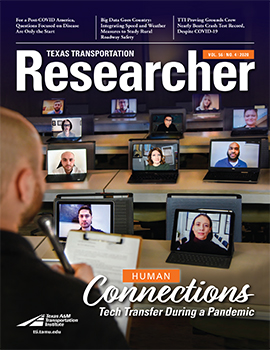
I’m a people person. I draw energy from interacting with other folks. I’ll take an in-person conversation over a phone call every time. But lately, traditional face-to-face contact has been supplanted by the virtual kind.
COVID-19 has transformed how we interact. Worldwide, nearly 1.5 million folks have perished as I write this. For mutual protection, we’ve had to disrupt some of our most beloved cultural traditions — from handshakes to hugging grandma — to slow the viral spread.
In transportation research, we use the term “human factors” to describe how humans interact with technology through the environment; but I’d like to redefine it here for a moment. The human factor (emphasis on human) encompasses everything we share when we communicate with one another — through tone, expression, body language, and simply sitting at the same table.

Since March, we’ve learned to rely heavily on the Internet to conduct business. Like many other organizations, the Texas A&M Transportation Institute (TTI) has embraced web-based technology and migrated in-person conferences, symposia and business meetings to cyberspace. We’ve all had to become technical experts — or, at least, passably competent users of webcams and microphones — while redefining the protocols of professional meetings to accommodate wandering children and excitable pets. And we’ve done it with a patience and understanding toward one another, remarkable in part because of their regrettable rarity these days.
As transportation researchers, our victories come when human ingenuity applies technology to make transportation better: safer cars, longer-lasting roads, stronger bridges. What sometimes gets lost in all the physics and math is recognizing the importance of the human factor in the equation. Brainstorming with colleagues, briefing sponsors, training practitioners in new concepts and methods — all are examples of interpersonal technology transfer and information exchange. When things get back to normal, it’s worth remembering that the clear, effective communication of research takes more than language. It requires gestures, expressions and tone of voice. It requires a human connection.
The Internet is sometimes knocked for imposing distance and limiting personal interaction. That seems a bit ironic nowadays, doesn’t it? Imagine trying to share research without your favorite virtual meeting program. And do me a favor the next time you’re online with a colleague — do a little gut check. See if you don’t feel just a little more connected when your colleague’s face lights up the screen.
What will social norms look like post-COVID-19? We don’t know yet. I suspect a lot of us will be working remotely on a semi-permanent basis. One thing’s for sure, though: the need to socialize is as deep in our DNA as the need to survive.
